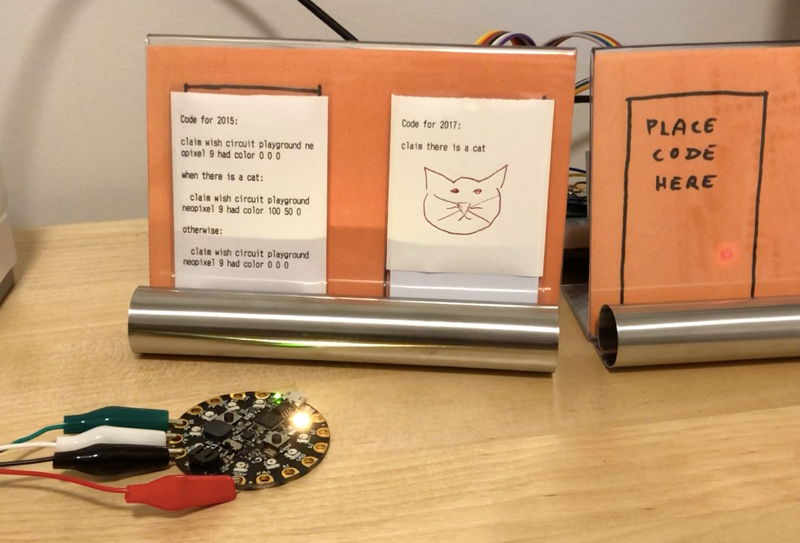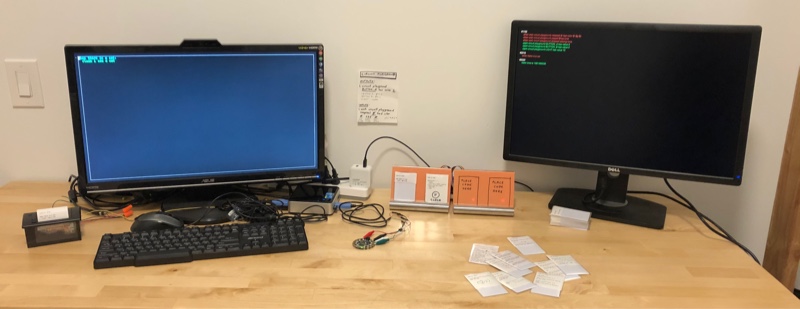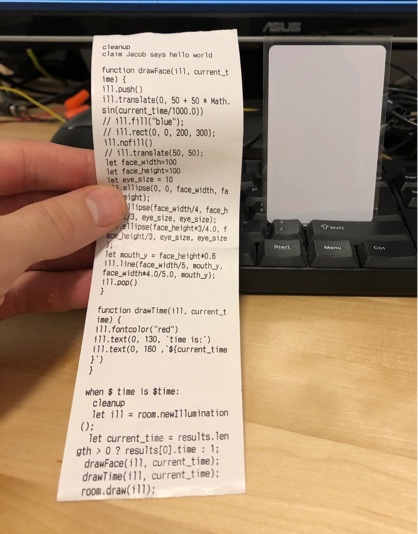

February 11, 2020
I am exploring the idea of "programmable spaces" — where the concept of a computer is expanded outside a little rectangular screen to fill the entire room. Interacting with the programmable space means using physical objects, not virtual ones on a screen. Bringing computing to the scale of a room makes it a communal and social experience.
When describing programmable spaces to other people I usually end up saying "you just have to see it in person." My previous explorations have relied on room installations of cameras and projectors and careful calibration so I rarely transported the system. I wondered what the "minimum viable demo" was and if the programmable space idea could be simplified and made mobile without losing its emergent properties.
A common idea throughout all of my programmable space explorations has been the physical manifestation of code — primarily source code printed on full size pieces of paper with annotations like colored dots so cameras can track the papers. For a minimum viable demo, the physical manifestation of code needs to be small, portable, and easy to sense without much setup or calibration. Tabletop card games seemed like a good parallel: they are portable, familiar, and can have complex rule systems built up from effects described on the cards themselves. I also like games as parallel in the hopes that the programmable space would be designed for play and self guided exploration and not "serious matters".
In this attempt at a minimum viable programmable space, programs are represented physically by RFID cards in plastic sleeves with the program source codes printed on receipt paper.

Programs are run when they are placed on a stand that has a RFID sensor behind it. One of the core ideas of a programmable space is that all code should be out in the room and shown in a way that people can read the code and learn what is going on. The code printed on the receipt paper helps people understand what a program does and the RFID card helps the room system know where each program is. This setup is similar to my March 2019 exploration that used full sized pieces of papers and clipboards.
 The entire setup on a desk.
The entire setup on a desk.
The picture above shows the entire layout of the demo. In the middle are the orange program sensors — when a program is placed on them then its code is run. On the left is the program editor: When a program is placed on the left-most sensor, its source code is shown on the editor. When a new version of a program's code is saved, it is printed out on the receipt printer to the left of the editor. On the right screen is a list of all the facts and subscriptions for running programs: this is a tool for seeing the inputs and outputs of the room without having to read all the code. In the middle of the desk is a Circuit Playground Express — an electronic board with many built in sensors and outputs. Its buttons, light sensors, lights, and speaker are connected to the room.

But this demo was more constrained than my other programmable space demos and I wondered if the idea could be compressed this small. Only a few programs can run at the same time and the only inputs and outputs are on the same little electronic board. Maybe it needed the emergent properties of being room-scale to make sense.
I have also thought a lot about the idea from Andy Matuschak and Michael Nielsen's essay How can we develop transformative tools for thought? where they differentiate an education media and canonical media. Educational media may be simple and easy, but it is not used by professionals to do real work. On the other hand, canonical media "expand[s] its range, and set a new standard widely known amongst creators in that medium". My aspiration for this project is not to create a toy, but be a medium that surpasses current limitations of how technology can live naturally in a space while also empowering more people to create and think with computational ideas.
I tested the minimum prograble space with a couple people to see if it was a hint of the future or just a toy. The test was designed to introduce the system to someone that had written some code (not necessarily professionally) through a collaborative explanation. The goal was to see how quickly they understood the system and if they were able to get past the technology and into creative play.
Show how placing a program on the stand makes it run. Its claims are shown in green on the list of programs.
Show how a program can listen for claims by other programs and respond. The things it is listening for are shown in red.
Make a first program by taking an empty program off the stack, writing the source code using the editor, printing the code,
and then putting it on a stand to run it.
The goal is that people can look at any program in the room and get a sense of what it does.
Show them a card and have them describe what it does.

The rest of the test is spent on freeform play using the buttons, lights, and sensors of the Circuit Playground. The Circuit Playground's abilities are shown in the list of programs and serve as a reference for new programs that want to use its inputs and outputs.
Here are a few example programs made during this time:
Most things worked well and this demo confirmed a programmable space system can be portable while still being interesting.
But some things weren't great:

Overall, card-size programs seem like a promising directions for informal objects that can live in a home. I think it is important that the system be always running so that it can be normally ignored but then used immediately. The projectors and cameras used in my other programmable space prototypes are too intrusive to have always on inside a home and I have been turning them off when not in use. I have similar feelings about VR and AR: they aren't something I want to have on all the time. This RFID card system was the first prototype I noticed myself leaving on and ignoring.
I'm curious how the RFID card's ideas will scale up to multiple rooms. Going beyond one room is an exciting milestone in my vision to have the technology live everywhere while also bringing challenges of multi-room coordination. For example, how do multiple rooms share code between each other? I foresee the need for cards to transform sizes or sensing modes (i.e. transforming a card program into a full size paper program) so code longer than a card can be written. The tabletop card game parallel has also inspired me to make a social and room-scale board game using this card system. Lots of fun ahead!
If you have thoughts or questions, feel free to email or reach out to me on Twitter.